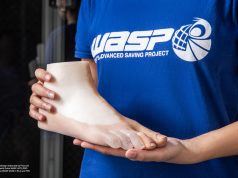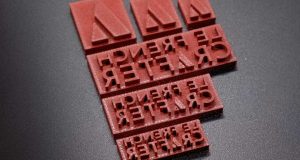Linde will be exhibiting a number of flagship gas technologies at this year’s Formnext (15-18 November), including its bespoke gas mixture developed specifically to optimize printing in laser powder bed fusion processes; pioneering gas atomization solutions for metal powder production; its turnkey offering to help accelerate the use of the special alloy nitinol, plus the opportunity to confidentially discuss innovative technologies to combat the market for counterfeit additive manufactured parts.
“Linde has long been a pioneer in the development of innovative gas technologies to optimize manufacturing processes”, said Pierre Forêt, Associate Director Additive Manufacturing, Linde. “In this rapidly developing world of additive manufacturing, we are delighted to be showcasing some of our most groundbreaking solutions at Formnext”.
Turnkey solution for nitinol printing
Nitinol (NiTi) is a metal alloy of 50/50 nickel and titanium with unique properties, including superelasticity and “shape memory effect”, meaning it can change its shape when heated and return to its original shape when cooled. Increasingly used in the medical and dental industries for orthopedic implants, stents and orthodontic parts, and in aerospace for solar panels, manufacturers of nitinol products face challenges as they are difficult to machine and product design is limited to simple structures. Additionally, traditional machining results in excessive tool wear, high cutting forces and surface degradation. While laser bed powder fusion (LBPF) additive manufacturing offers greater design freedom and production efficiency, there are still issues to be overcome when printing with nitinol.
Vaporization of the nickel during the laser enabled process can lead to a decrease in the nickel / titanium ratio, thereby increasing the transformation temperature. Additionally, oxygen pick-up inside the material can also affect the transformation temperature, negatively impacting on shape memory and affecting the overall performance of the intended application. Surface oxidation can also be an issue, meaning the part needs significant post-production cleaning. To avoid both issues, it is vital to reduce the amount of oxygen in the print chamber. To ensure stringent control of oxygen levels, Linde and 3D Medlab have collaborated to optimize the print atmosphere using Linde’s ADDvance O2 precision oxygen monitoring system and ADDvance Laser230 process gas mixture.
ADDvance O2 precision
Even after the most rigorous purging of the print chamber atmosphere, it is possible for minor impurities to still remain present. Extremely small variations in oxygen levels can impact the mechanical properties of alloys sensitive to oxygen – including process induced aging of the metal powder. ADDvance O2 precision provides continuous analysis of the gas atmosphere. Recognizing O2 concentrations as low as 10 ppm, ADDvance O2 precision initiates an automatic purging process to maintain optimal atmospheric conditions.
ADDvance Laser230
A bespoke gas mixture developed specifically to optimize printing outcomes in laser powder bed fusion (LPBF) processes, the ADDvance Laser230 process gas combines argon with helium to reduce particle redeposition, porosity and powder loss by up to 20%. It also increases the lifecycle of the printer – and with fewer changes of filters required, it also saves on maintenance time. In addition, it mitigates fume formation and accelerates cycle times, making the printing process safer and lowering the cost per part. It is alloy agnostic and ideal for additive manufacturing of lattice structures.
ADDvance Sinter250
A gas enabled solution for binder jetting, ADDvance Sinter250 optimizes sintering atmospheres to avoid oxidation in metal fused deposition modeling (FDM). Linde has developed a range of highly tailored gases – from pure argon and hydrogen to special argon/hydrogen gas mixtures for advanced atmosphere control. ADDvance Sinter250 is ideal for ensuring the integrity and strength of parts printed from stainless steel powders.
Hot gases
When producing metal powders, high volumes of gas need to be injected at high pressures through a nozzle. By using a heater to increase the temperature of the gas to several hundred degrees, the gas can move at faster speeds through the nozzle, enabling finer powders to be created or allowing for reduced gas consumption. The gas heater can be retro-fitted and Linde offers a turnkey solution including heater, control panel and gas supply.
Atomization test bench
The test bench laboratory – which will be operational in March 2023 – will enable the testing of industrial scale gas parameters to advance the understanding of gas behavior when used in a typical metal powder atomizer. As innovative additive manufacturing technologies have made significant advances to the process itself, the demand for novel metal powders has grown significantly.
While being vast in size, and requiring multi-million-dollar investments, standard metal powder atomizers are unsuitable for the observation and analysis of gas behavior as parameters are adapted.
Linde’s new laboratory is not only a much smaller scale version (1.60 meters high) of a typical atomizer, but has specially adapted windows, lighting, high-speed cameras and schlieren imaging allowing for surveillance and data capture of each change of gas parameter. It does not rely on the introduction of molten metal, instead using data from the simulated process to provide evidence of gas behavior under certain conditions. The different parameters to be assessed include gas type, volume of gas, pressure and temperature, with the miniature atomizer able to rapidly switch over to analyze hundreds of combinations within minutes.
The laboratory will enable Linde to develop new technologies to improve the atomization process – particularly increasing yield and process stability. Linde will also collaborate with powder manufacturers and OEMs to help them test specific gas behaviors on the test bench, allowing them to then scale up the results on their large atomizers.
Solutions to combat counterfeit additive manufactured parts
With often vast and complex global supply chains supporting manufacturing industries, fraudulent and inferior parts can enter that chain, resulting in poor part performance – or in worst cases catastrophic failures.
Linde is inviting visitors to Formnext for confidential discussions on how Linde can help identify counterfeit parts and ensure part reliability.
For more information about Linde, please visit www.linde.com.
Subscribe to our Newsletter
3DPResso is a weekly newsletter that links to the most exciting global stories from the 3D printing and additive manufacturing industry.
























